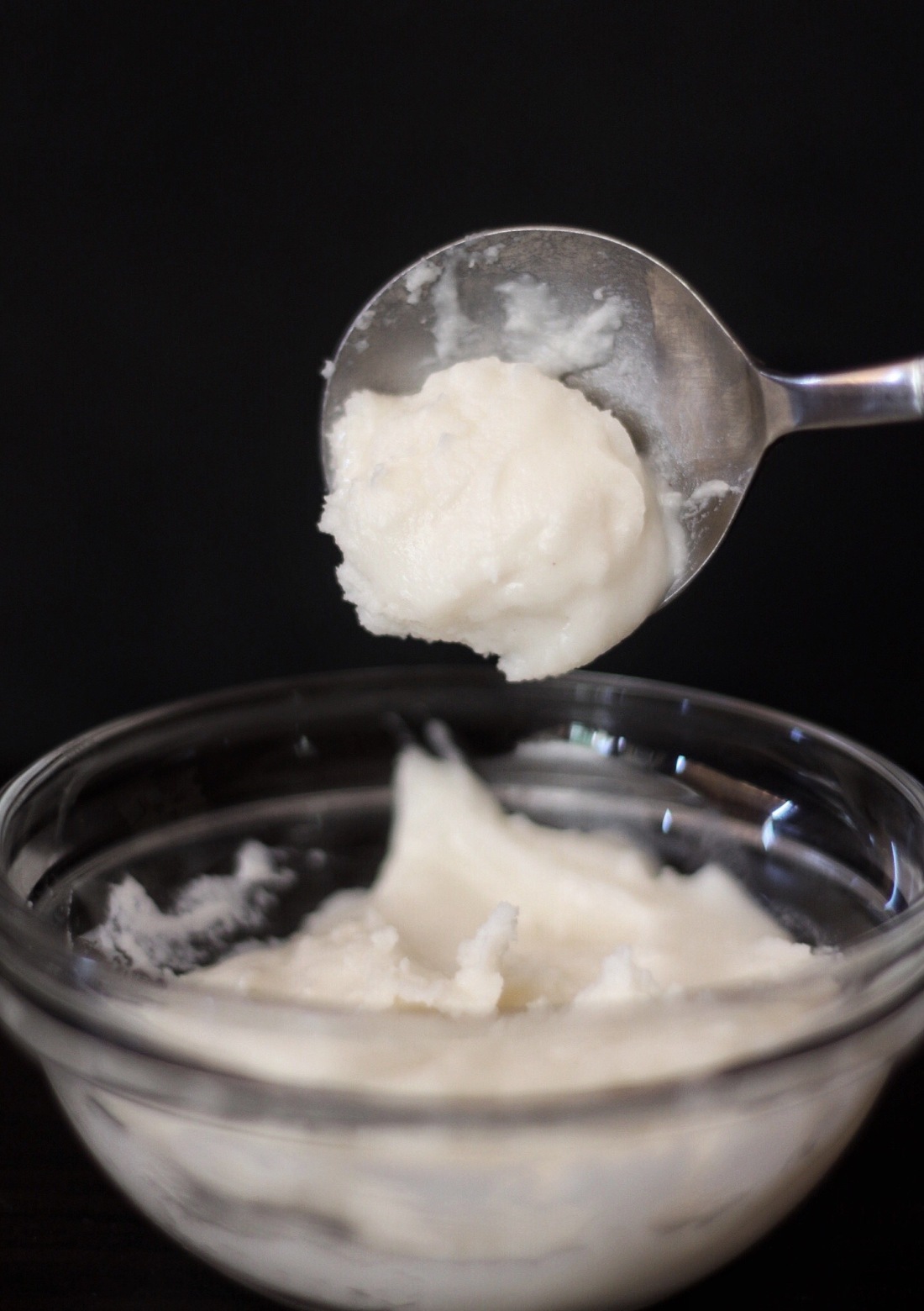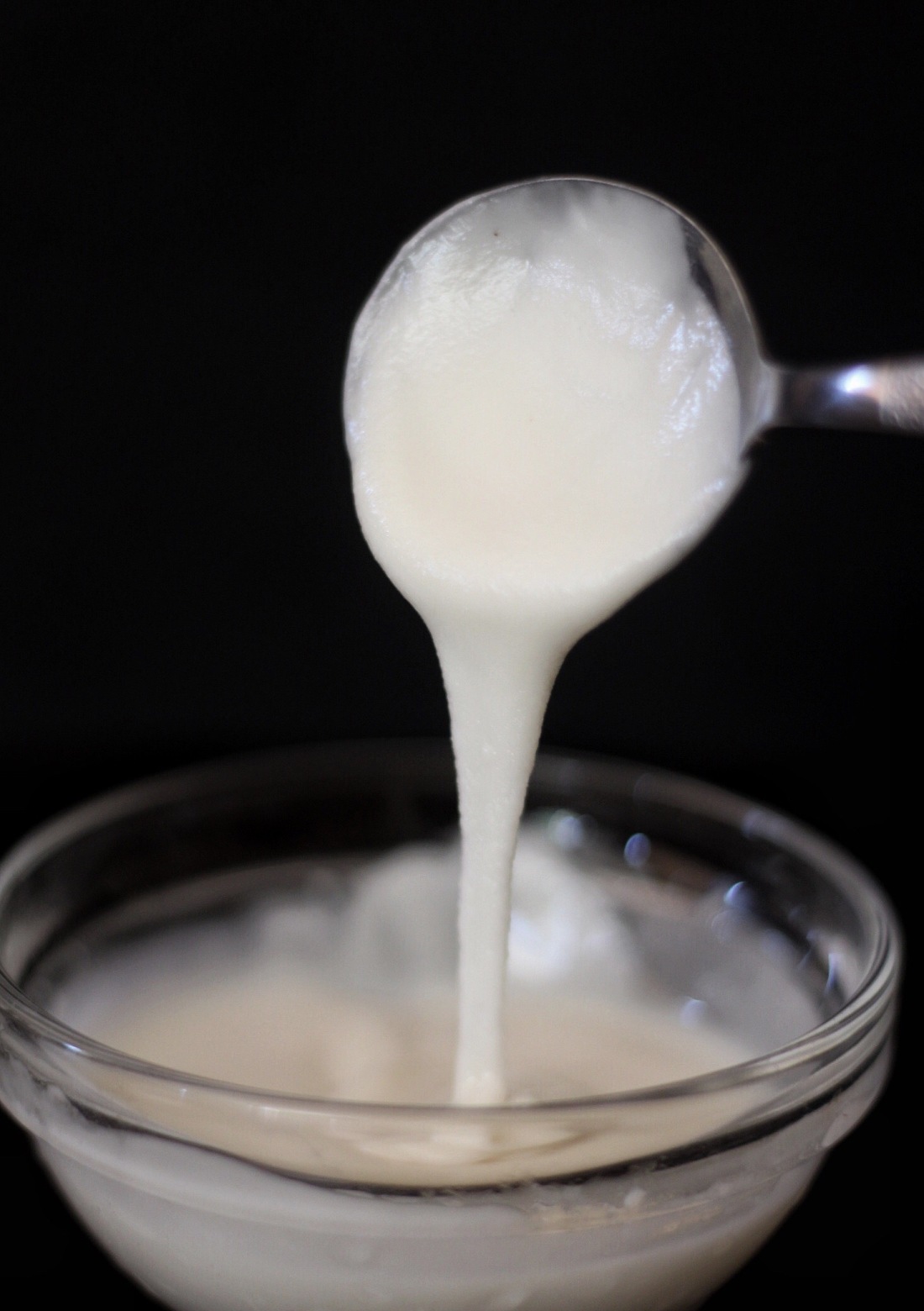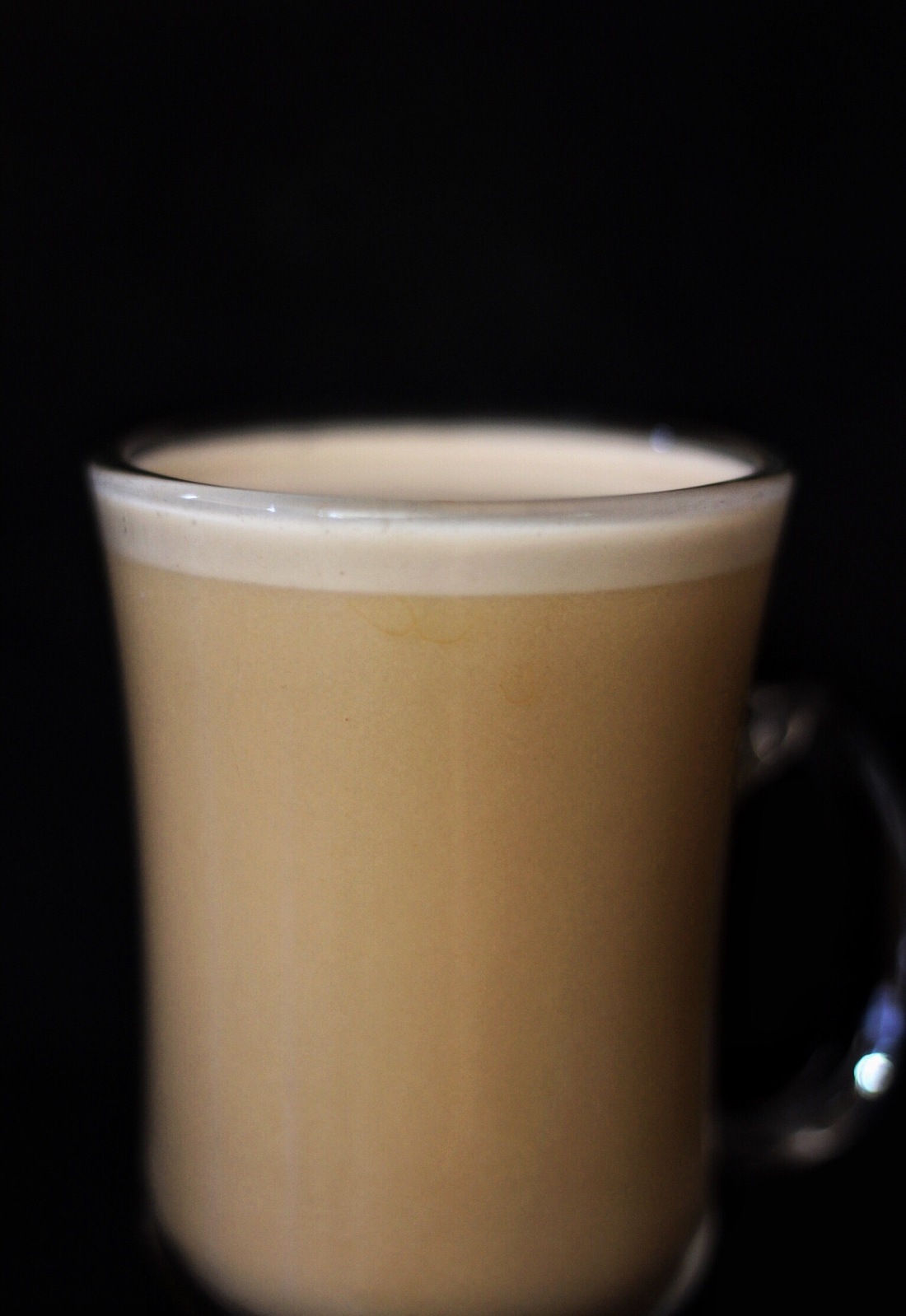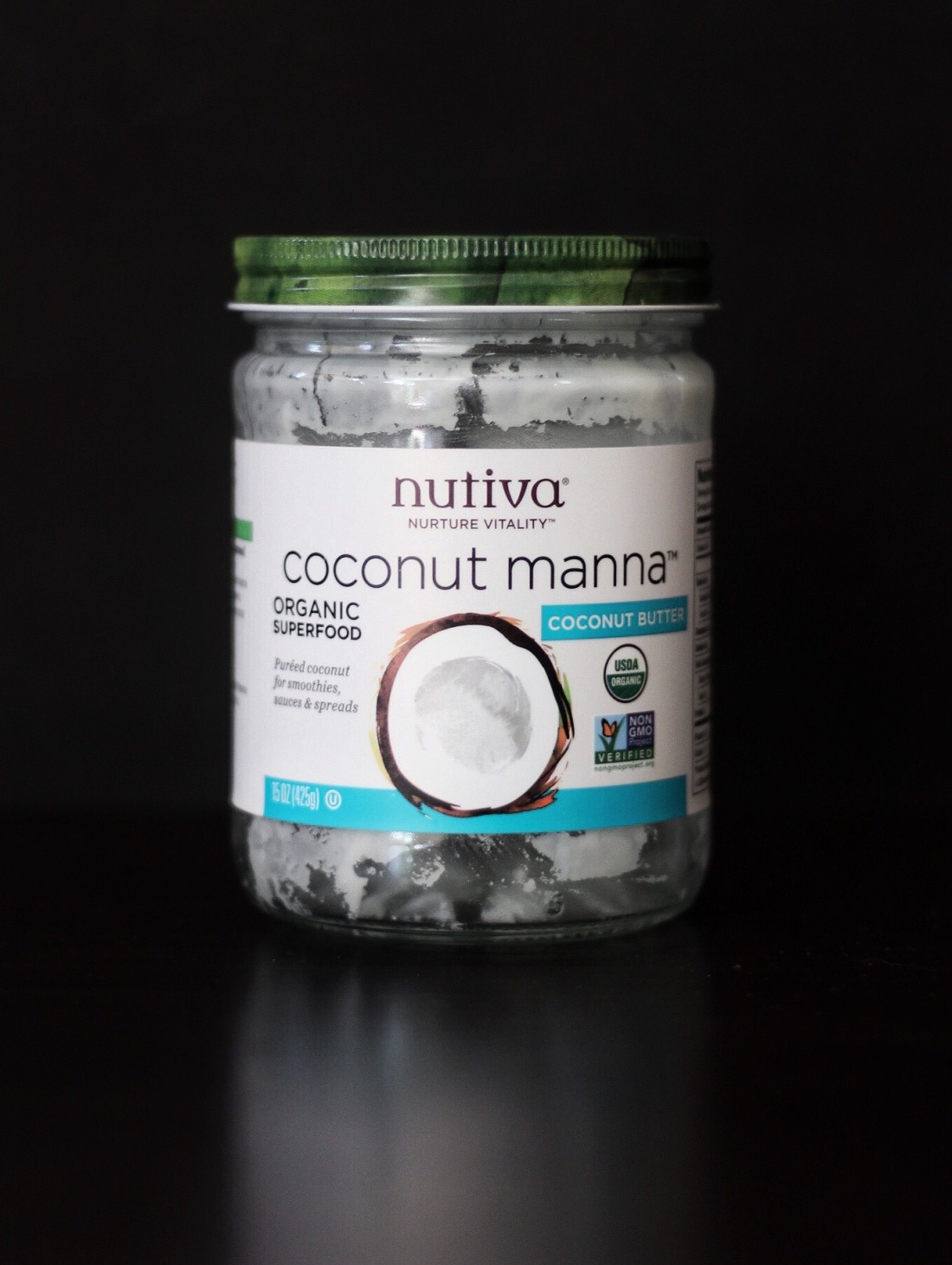What is coconut butter?
Coconut butter is thick, creamy, coconut puree, made from finely blended shredded coconut. It has a similar texture to creamy peanut butter with a lightly sweet, subtle coconut flavor. Coconut butter is 80% fat; 1 tablespoon has roughly 9 grams of fat (8 grams of which are saturated), 3 grams of carbohydrates, 1 gram of sugar, and 1 gram of protein. The saturated fats in coconuts increase the body’s ability to use ketones – fatty acids that fuel cells more efficiently than simple carbohydrates (glucose, fructose, sucrose, etc).
When coconut butter is around 75° F and higher, it’s consistency is thick and runny. When it’s temperature is around 70° F and lower, however, it’s consistency is more solidified and crumbly, with the fat separated to the top of the dry matter. To loosen up the coconut butter, place the jar in a bowl of warm/hot (not boiling) water for 5-10 minutes and stir vigorously.


How is it made?
Coconut butter is made by blending dried, shredded coconut until completely smooth. If you have a high quality food processor, you can make some of your own by blending dried shredded coconut in your food processor for 10-15 minutes, exactly how all nut butters are made. However, because my food processor isn’t as capable as others, my homemade coconut butter attempt end up with lil’ clumps of coconut in runny pools of liquid, so I stick with the jarred, store bought varieties.
Uses of Coconut Butter:
Converting Coconut Butter into Coconut Milk
Coconut butter can be easily converted into coconut cream by mixing 1 part coconut butter with 1 part water (1/2 c coconut butter + 1/2 c water), or converted into coconut milk by mixing 1 part coconut butter with 5 parts water (3 tbsp coconut butter + 1 c water). Simply shake or blend coconut butter directly into warm or cool water, although if mixed directly into cold water, the milk will be a little gritty. With this same concept in mind, in place of coconut milk in smoothies I simply use water as my main liquid and add 2-3 tablespoons of coconut butter.
Try Using Coconut Butter as Coffee Creamer
In place of half & half or other creamers, blend 1-2 tablespoons of coconut butter straight into coffee, chai tea, black tea, and other hot beverages until frothy and milky in color.
Additionally, when coconut fat is mixed with caffeine and consumed on an empty stomach (before breakfast), the entrance of adenosine – chemicals that induce sleepiness – are temporarily halted from entering the brain by caffeine, and coconut’s fats encourage the body to reach for ketones instead of glucose, as a fuel source, allowing you to go longer lengths of time without feeling hungry.
However, there’s little scientific evidence to support the hunger reducing/energy enhancing effects of the combination of medium chain triglyceride fats (the ones found in coconut) and caffeine. Albeit, I find the concoction to be very effective in keeping me focused, alert, and energized for 3-5 hours before getting hungry.

Other Uses
Coconut butter can also be used on bread, as the main ingredient in icings, or eaten by the spoonful… which I do all the time, by the way.
Overall
Ever since I discovered I could replace both coconut milk and coconut cream with coconut butter, it’s become a staple in my pantry that I use on average of three times a day; I really do love this stuff.

How to Make Coconut Milk or Cream from Coconut Butter
The easiest method of making coconut milk or cream.
Ingredients
Coconut Milk
- 1 c hot water (it doesn’t need to boiling)*
- 3 tbsp coconut butter
Coconut Cream
- 1/2 c hot water*
- 1/2 c coconut butter
Directions
- Combine coconut butter and water in a blender or sealable cup and blend or shake for 10-15 seconds, until creamy and smooth.
- Use in coffee, soups, and in any application where coconut milk or cream is called for. Use immediately or store in the fridge for up to 2 weeks. When ready to use again, reheat in a sauce pot over medium heat until the solids are liquified and shake or blend to homogenize the mixture.
*Cold or room temperature water can also be used, however, it will most likely be slightly gritty.

The coconut milk, is that cereal type milk or the canned coconut milk for curries? If so do you have the other ratio version?
LikeLike
Is it possible to make coconut whipped cream either directly from coconut butter or from the coconut milk described in this URL? The recipes on other websites for whipped coconut cream all call for specific brands of cans of coconut milk so I was curious. This page has great BTW. Thanks!
LikeLike
Hey there!
Good question! While I haven’t tried it, I believe that the version made with coconut butter won’t be emulsified enough to make a good coconut whipped cream. For that reason, I don’t think straight up coconut butter or the cream made from it would be good options for what you’re looking for.
It is funny that many bloggers specify on specific brands, however I guess we’re no different! Because the best “coconut whipped cream” we’ve found is the “Coconut Whipping Cream” by Nature’s Charm. It’s available in many grocery stores and works beautifully. As opposed to normal coconut milk or coconut cream, you can use every bit of their “whipping cream” variation; not just the solidified fat on top.
All that being said though, no coconut product out there gets the same consistency as real dairy cream! I know that’s a given, but just thought I should set that expectation, haha.
Hope this helps!
LikeLike
Thank you, very thoughtful answer. I appreciate it and this website!
LikeLike
If I have 150g of coconut butter, can I just make 750ml of coconut milk?
LikeLike
Hey Bharat!
If you have 150 grams of coconut butter, you can make 800ml (800 grams) coconut milk.
Let me know if this helps!
Best,
Ryan
LikeLike